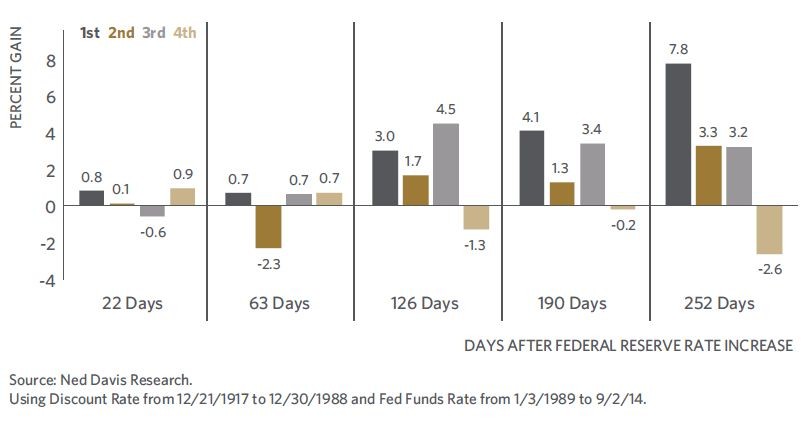Investors begin bracing stock and bond portfolios for first rate hikes
Post on: 16 Апрель, 2015 No Comment

BenEisen
NEW YORK (MarketWatch) – The Federal Reserve pinged investors of all stripes last week with a warning: the central bank’s key lending rate is eventually going to rise, and it may lift off sooner than the market thinks.
In response to what’s likely to be a gradual transition to more normalized monetary policy in the coming years, stock and bond buyers should keep their eyes forward to prepare for a market where easy gains are rarer and certain traps may await, investment strategists say.
The Fed helped provide a tremendous boost to markets over the last half decade when it pushed its fed funds target rate down to near zero amid the wreckage of the financial crisis. Then it provided another dose of adrenaline when it partook in a bond-buying stimulus program, bringing interest rates down to historic lows. In turn bond prices surges and stocks made fresh record highs.
Now, as the central bank winds down its asset purchases and prepares to raise rates, investors will have to get used to an environment where “the Fed is not lifting all boats,” says Jim Russell, senior equities strategist at U.S. Bank Wealth Management.
“We will likely see more performance dispersion, not just among sectors, but sometimes within the same sector,” said Russell. “It’s more of a stock-pickers market.”
Still, certain sectors that are bolstered by the current low rate environment may lose their luster. A number of strategists point to the utility sector DJU, -0.93% , which tends to include high dividend yielding stocks, as one that might not hold up in a rising rate environment.
“They tend to be stable companies that people generally buy for the dividends,” said Russ Koesterich, chief investment strategist at BlackRock. “So utilities are like a bond market proxy, where valuations compress as rates rise. People pay less for a dollar of earnings in a higher rate environment than a lower rate environment.”
REITS at risk?
Real estate investment trusts and telecommunications firms could also be seen as investments that benefit from low rates, strategists said.
With rates low, investors have embarked on an expansive search for income, which has included buying dividend stocks like utilities and REITS, as well as buying up securities in the corporate bond market. That means corporate bonds issued by REITS and utilities also appear to be sensitive as investors inevitably retreat, according to credit strategists at Bank of America Merrill Lynch Global Research.
“Generally speaking, strategies that worked well in the low-growth, low-interest rate environment following the credit crisis, where investors reached for yield, should be most vulnerable to higher interest rates and the ‘un-reach’ for yield,” said Bank of America analyst Yuriy Shchuchinov, in a report this week.
Instead, strategists suggest that stocks poised to benefit the most are the cyclical sectors that rise alongside an improving economy. After all, the Fed has said it will only pull back its accommodation if it sees evidence of an economy that is accelerating. Energy and technology sectors could fit into that category, says Koesterich. Dan Morris, global investment strategist with TIAA-CREF, adds in the financial sector, which would “benefit from higher interest income,” as rates rise.
Corporate bonds
The corporate bonds sold by cyclical sectors are also likely to hold up the best when rates rise, according to Shchuchinov.
Nonetheless, as investors have bid up corporate bonds DJCBT, -0.22% the premium they pay over comparable Treasurys has narrowed substantially. That means most corporate bonds are susceptible to rising rates, and as Treasury prices fall, corporate bonds could fall too.
“Almost the entire sector of the corporate bond market has higher correlations,” to Treasurys, said Jeffery Elswick, fixed income manager at Frost Investment Advisors. So instead of making plays on the entire sector, Elswick said he is, “spending more time with individual idea names.”
Additionally, emerging market corporate and sovereign bonds may be an attractive buy for some, given that it has already weakened substantially this year, Morris notes. That means it’s likely to be less sensitive as rates rise. “You are getting, I think, fairly compensated for the risk,” he said.
As the Fed moves toward its first rate hike, and, just as important, as the market tries to guess when the Fed will hike rates, intermediate-sector Treasurys are likely to react most strongly. That was evident in the wake of the Federal Reserve’s policy announcement last week, when the 5-year Treasury yield pushed sharply higher.
“These are the bonds that will be the most sensitive if investors move forward their expectations of when the Fed is raising rates,” said Koesterich.
Lifting barbells
Given this sensitivity, Koesterich and other money managers are now advising to avoid vulnerable maturities in the middle of the yield curve. Instead, they suggest buying the shortest-term bonds and longer-term bonds, in what’s known as a barbell strategy, which may avoid the brunt of the yield curve impact of rising rates. Nonetheless, others have remained committed to the one-to-five year sector of the yield curve, including Pimco’s Bill Gross.
As investors plan ahead, it’s worth remembering that the Fed’s warning of eventual rate hikes was just that – a warning. Even with fears running high, the lift-off for the policy rate is at least a year away, which means investors have time to plot a path forward. And when the rate hikes do come, they are likely to be slow and gradual.
“When it does start, it will be very slow and it will be very gradual. For good or for bad, stock investors can take some comfort in that,” said Morris.














